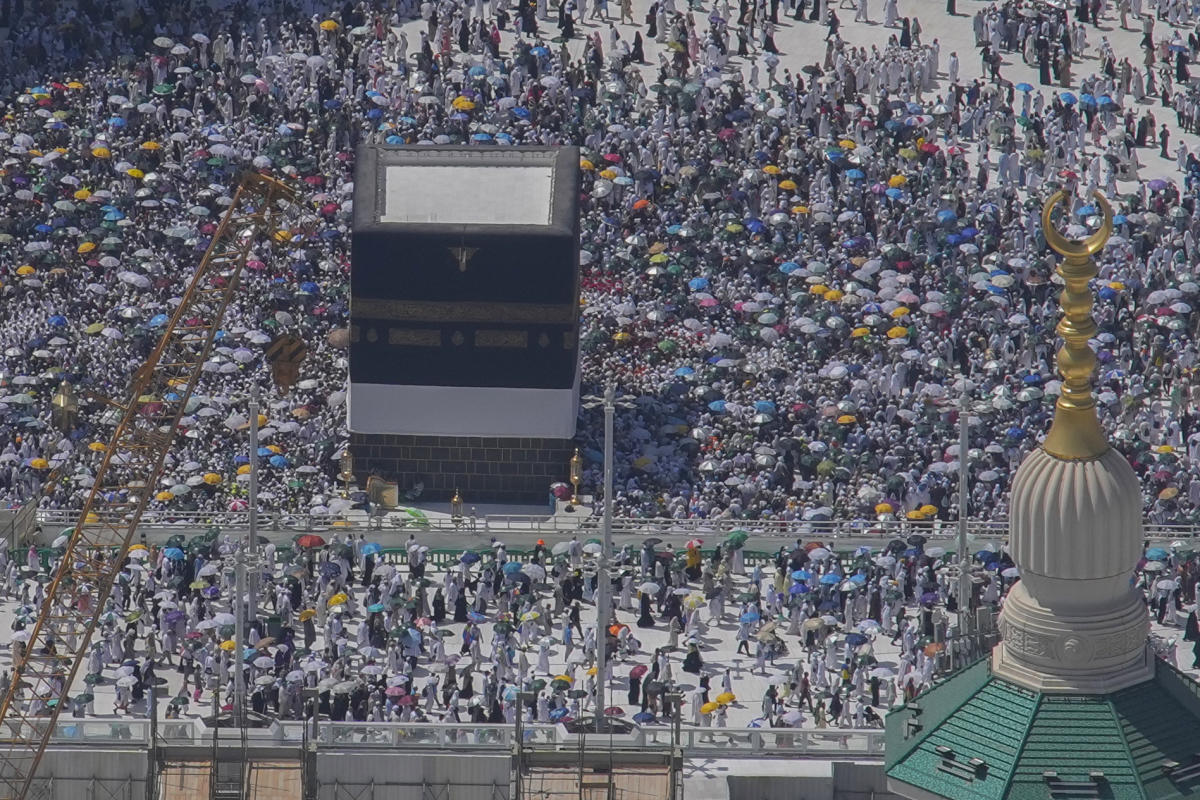MINA, Saudi Arabia (AP) — Muslim pilgrims used the early morning hours Monday to carry out the second day of the symbolic stoning of the devil, hoping to escape the summer heat that caused sunstroke and sunburn among thousands who performed the hajj completed pilgrimage.
The last days of the Hajj coincide with the celebration of Eid al-Adha by Muslims around the world.
The stoning of the pillars representing the devil takes place in Mina, a desert plain just outside the city of Mecca in Saudi Arabia. A third stoning is planned for Tuesday, before the Farewell Tawaf, or around the cube-shaped Kaaba in Mecca.
The pilgrimage is one of the five pillars of Islam. All Muslims are required to perform the five-day hajj at least once in their lives, if they are physically and financially able to do so. The hajj rituals largely commemorate the stories in the Quran about the prophet Ibrahim, his son, the prophet Ismail, and Ismail’s mother Hajar – or Abraham and Ishmael as they are called in the Bible.
The rituals took place under high summer heat, which reached 48 degrees Celsius (118 degrees Fahrenheit) at 2 p.m. in Mecca and the holy places in and around the city, according to the Saudi National Center for Metrology.
“Of course it is something very difficult and tiring. The temperature is abnormal compared to previous years and this affects us a lot,” said Ahmed Al-Baradie, an Egyptian pilgrim, after completing his second symbolic stoning.
According to the Ministry of Health, more than 2,760 pilgrims suffered from sunstroke and heat stress at the start of the first round of stoning on Sunday alone. Jordan announced on Sunday that fourteen Jordanian pilgrims had died of heatstroke.
The number of pilgrims on the roads leading to the pillars fell significantly on Monday morning compared to Sunday.
Carrying an umbrella against the blazing sun, Pakistani pilgrim Khoda Bakhch visited the stoning site Monday morning and planned to return at sunset. “After two or three hours the temperature can be too high,” he said.
Experts say heat exhaustion and heatstroke are likely to become more common in high temperatures, with symptoms including heavy sweating, dizziness, muscle spasms and vomiting. Heat stroke is the most serious heat-related illness and occurs when the body can no longer sweat.
Security forces, medics and first responders have been deployed in and around Mina, especially on roads and open areas, to guide and assist pilgrims. They treated many people for sunburn on their feet.
“I am really impressed with the preparations,” Sani Abdullah, a Nigerian, told The Associated Press, adding that he was used to such scorching heat in his country. “I’ve never had any problems. Everything is going smoothly.”
Later in the day the sky became cloudy and it rained for a while, which helped alleviate the stress of the desert heat.
Mina is where Muslims believe Ibrahim’s faith was tested when God commanded him to sacrifice his only son Ismail. Ibrahim was willing to submit to the command, but then God stayed his hand and spared his son. In the Christian and Jewish versions of the story, Abraham is ordered to kill his other son, Isaac. The holiday Eid al-Adha celebrates Ibrahim’s submission to God.
The stoning began on Sunday, a day after the pilgrims visited the holy Mount Arafat, where they spent their day in worship and reflection. The ritual on Mount Arafat, known as the Hill of Mercy, is considered the pinnacle of the Hajj pilgrimage.
The pilgrims collected the pebbles, which they used in the symbolic stoning of pillars, from Muzdalifa, an area several kilometers away from Mount Arafat.
The Hajj is one of the largest religious gatherings on earth. The rituals officially began Friday when pilgrims moved from the Grand Mosque of Mecca to Mina and then to Mount Arafat. They then return to Mina, where they spend up to three days, each throwing seven pebbles at three pillars in a ritual to symbolize the rejection of evil and sin.
While in Mina, the pilgrims visit Mecca to perform a ‘tawaf’ or circumambulation, circling counterclockwise around the Kaaba in the Grand Mosque seven times. Then another circumambulation, the Farewell Tawaf, will mark the end of the Hajj as pilgrims prepare to leave the holy city.
Once the Hajj is over, men are expected to shave their heads, and women are expected to cut off a lock of hair as a sign of renewal.
Most pilgrims then leave Mecca for the city of Medina, about 210 miles away, to pray in the Prophet Muhammad’s tomb, the Holy Chamber. The tomb is part of the Prophet’s Mosque, one of the three holiest sites in Islam, along with the Grand Mosque in Mecca and the Al Aqsa Mosque in Jerusalem.
This year’s hajj took place against the backdrop of the devastating war between Israel and Hamas, which brought the Middle East to the brink of regional conflict.
Gaza health officials say the war has killed more than 37,000 Palestinians in the besieged strip, while hundreds more have been killed in Israeli operations in the West Bank. It began after Hamas-led militants attacked Israel on October 7, killing about 1,200 people and taking about 250 hostage.
Palestinians in the Gaza Strip were unable to travel to Mecca for the hajj this year due to the closure of the Rafah crossing in May, as Israel expanded its ground offensive to the city on the border with Egypt.
According to data from the Saudi Ministry of Hajj and Umra, more than 1.83 million Muslims performed Hajj in 2024, slightly less than last year’s 1.84 million. This year’s figures include more than 1.6 million pilgrims from 22 countries, and approximately 222,000 Saudi citizens and residents.
